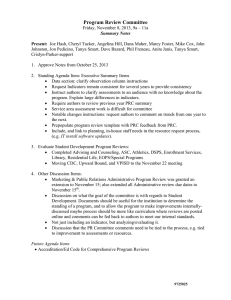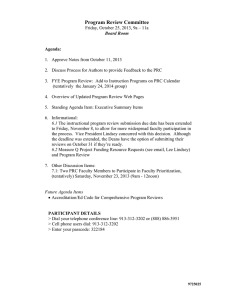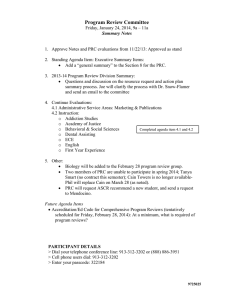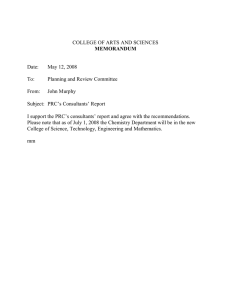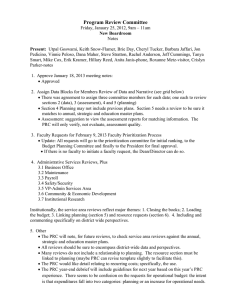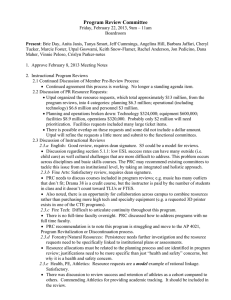Program Review Committee
advertisement
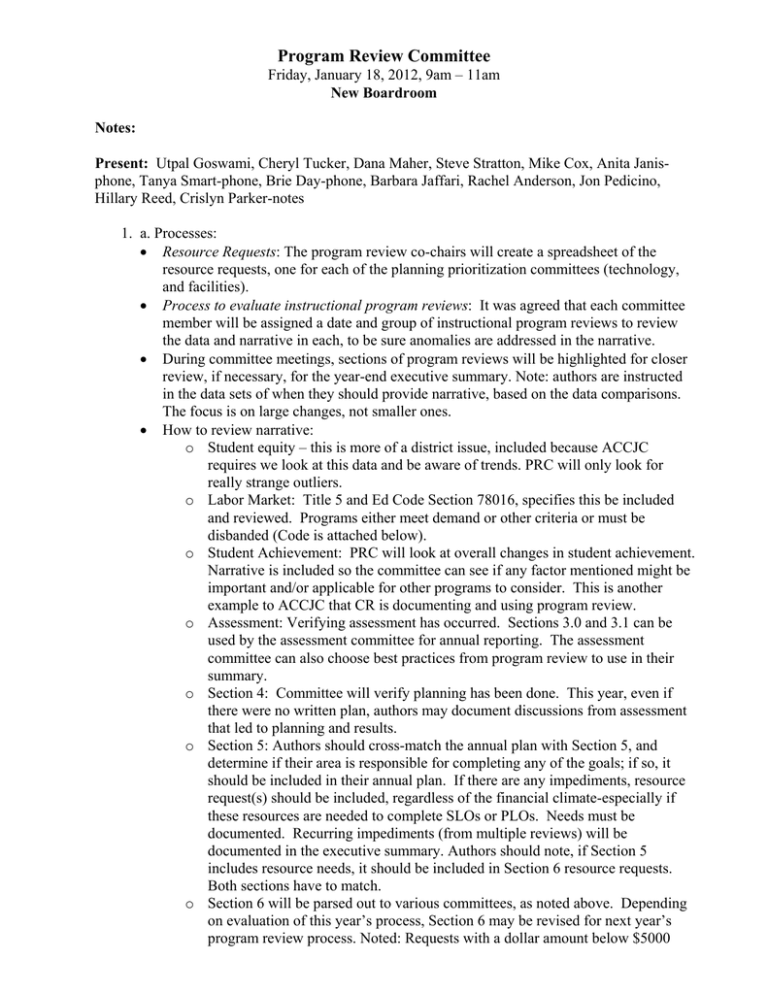
Program Review Committee Friday, January 18, 2012, 9am – 11am New Boardroom Notes: Present: Utpal Goswami, Cheryl Tucker, Dana Maher, Steve Stratton, Mike Cox, Anita Janisphone, Tanya Smart-phone, Brie Day-phone, Barbara Jaffari, Rachel Anderson, Jon Pedicino, Hillary Reed, Crislyn Parker-notes 1. a. Processes: Resource Requests: The program review co-chairs will create a spreadsheet of the resource requests, one for each of the planning prioritization committees (technology, and facilities). Process to evaluate instructional program reviews: It was agreed that each committee member will be assigned a date and group of instructional program reviews to review the data and narrative in each, to be sure anomalies are addressed in the narrative. During committee meetings, sections of program reviews will be highlighted for closer review, if necessary, for the year-end executive summary. Note: authors are instructed in the data sets of when they should provide narrative, based on the data comparisons. The focus is on large changes, not smaller ones. How to review narrative: o Student equity – this is more of a district issue, included because ACCJC requires we look at this data and be aware of trends. PRC will only look for really strange outliers. o Labor Market: Title 5 and Ed Code Section 78016, specifies this be included and reviewed. Programs either meet demand or other criteria or must be disbanded (Code is attached below). o Student Achievement: PRC will look at overall changes in student achievement. Narrative is included so the committee can see if any factor mentioned might be important and/or applicable for other programs to consider. This is another example to ACCJC that CR is documenting and using program review. o Assessment: Verifying assessment has occurred. Sections 3.0 and 3.1 can be used by the assessment committee for annual reporting. The assessment committee can also choose best practices from program review to use in their summary. o Section 4: Committee will verify planning has been done. This year, even if there were no written plan, authors may document discussions from assessment that led to planning and results. o Section 5: Authors should cross-match the annual plan with Section 5, and determine if their area is responsible for completing any of the goals; if so, it should be included in their annual plan. If there are any impediments, resource request(s) should be included, regardless of the financial climate-especially if these resources are needed to complete SLOs or PLOs. Needs must be documented. Recurring impediments (from multiple reviews) will be documented in the executive summary. Authors should note, if Section 5 includes resource needs, it should be included in Section 6 resource requests. Both sections have to match. o Section 6 will be parsed out to various committees, as noted above. Depending on evaluation of this year’s process, Section 6 may be revised for next year’s program review process. Noted: Requests with a dollar amount below $5000 will not necessarily be forwarded for consideration; however, multiple departments requesting the same type of resource, will be bundled and forwarded. Members reviewing the data/narrative, should write comments to section 7, to streamline the summary process. Note: if a funding source other than the general fund exists and is known, it should not be included in the resource requests; if the funding source is unknown, it should be included. If, at the committee level, linkage is not considered good, the committee will request authors resubmit, so all reviews will be accurate. b. Spring Meeting Calendar: It was discussed and agreed that the PRC will meet on the second and fourth Fridays of each month, at the same time. The PRC will meet on January 25, 2013. No objections to the second and fourth, instead. c. General Business: 2. Student Success Executive Program Review Summary: This is an internal student success document which can be a resource for the PRC to draw on for the final executive summary, and is posted with student success assessment documents. It will not be posted on the PRC site. 3. Other 4. Future Agenda Items: Data blocks for individuals reviewing data and narrative. Review Admin Services reviews. Faculty requests for February 9 faculty prioritization process Next meeting Friday, January 25, 2013 Ed Code regarding CTE and labor market data, etc.: 78016. (a) Every vocational or occupational training program offered by a community college district shall be reviewed every two years by the governing board of the district to ensure that each program, as demonstrated by the California Occupational Information System, including the State‐Local Cooperative Labor Market Information Program established in Section 10533 of the Unemployment Insurance Code, or if this program is not available in the labor market area, other available sources of labor market information, does all of the following: (1) Meets a documented labor market demand. (2) Does not represent unnecessary duplication of other manpower training programs in the area. (3) Is of demonstrated effectiveness as measured by the employment and completion success of its students. (b) Any program that does not meet the requirements of subdivision (a) and the standards promulgated by the governing board shall be terminated within one year. (c) The review process required by this section shall include the review and comments by the local Private Industry Council established pursuant to Division 8 (commencing with Section 15000) of the Unemployment Insurance Code, which review and comments shall occur prior to any decision by the appropriate governing body. (d) This section shall apply to each program commenced subsequent to July 28, 1983. (e) A written summary of the findings of each review shall be made available to the public.
